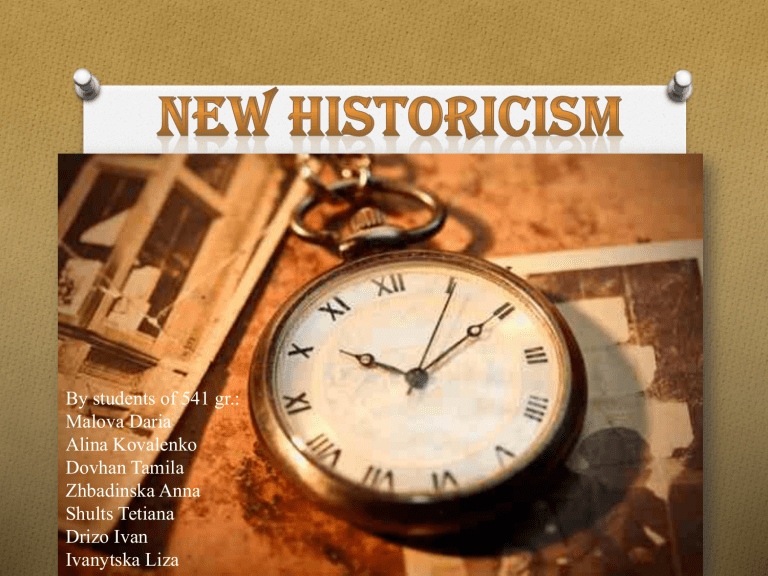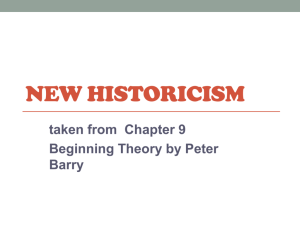New Historicism
advertisement

By students of 541 gr.: Malova Daria Alina Kovalenko Dovhan Tamila Zhbadinska Anna Shults Tetiana Drizo Ivan Ivanytska Liza New Historicism is a method based on the parallel reading of literary and non-literary texts, usually of the same time period; is a school of literary theory which combines critical theory into easier forms of practice for academic literary theorists of the 1990s. New Historicism is all about paying close attention to the historical context of the literary works. After all, play, poems, novels in general area product of the specific time and place. is an approach to literary criticism and literary theory based on the premise that a literary should be considered a product of time, place and historical circumstances of its composition rather than as an isolated work of art or text. Stephen Greenblatt American literary critic, theorist and scholar; professor at Harvard; one of the central figures of New Historicism movement; regarded by many as one of the founders of New Historicism (1980); his studies of the Renaissance was well-known as a major figure associated with New Historicism. Michel Foucault French philosopher, historian of ideas, social theorist, and literary critic; “the Godfather” of New Historicism; his work, including his studies of prisons, were pivotal to New Historicism; he believes that all human systems are symbolic and that works written could be related more to the readers when they know the time period, culture or political movements. The New Historicists want two things to study how a work of literature reflects its historical and sociocultural context to understand how a literary work comments on and relates to its context Key-points of New Historicism self-fashioning culture as text canon and non-canonical cultural poetics representation history discourse materialism circulation Self –fashioning Self-fashioning is a term introduced by Stephen Greenblatt in his work Renaissance Self-Fashioning. It is used to describe the process of constructing one's identity and public persona according to a set of socially acceptable standards. He made this term to describe the way that renaissance authors like William Shakespeare and Christopher Marlow created identities for themselves according to the social, cultural and political code of their time. Culture as a text Culture’s like a book. We can open it, read its rituals, social patterns, economic structures, and common behaviors as if they’re words or paragraphs, and that way we can understand how a culture works. Basically, the New Historicists think of culture as a text. And literary texts are little texts within this big text that is culture. Everything’s a text. Canon and Non-canonical Canon is the “best” literary works of a given language. Non-canonical works are the works that are not considered to be “high” literature study. non-canonical works alongside canonical works; including the works by authors who are non-white, non-male, from nonwestern cultures, or non-traditional modes of writing. Cultural poetics is another name for ‘New Historicism’; Stephen Greenblatt prefers to use “Cultural Poetics” to describe his own practice; new way to look for the historical sides of texts, it focuses on how it’s a way to look for the cultural sides of poetics. Representation A literary work (or an art work) that depicts aspects of social or cultural life is representing what those aspects are like in real life. W. Shakespeare. Romeo and Juliet Gabriel Garcia Marquez. One Hundred Years of Solitude History history isn’t just a list of facts that we compile; there are many different versions of history, so many different ways for it to show up in art or literature. Discourse is made up of a group of texts, statements, or utterances relating to a specific topic or theme; it’s important is to recognize how one book or thing someone says about a topic can be a reflection of the whole treasure trove of ideas already expressed about that issue. Materialism material conditions are really important in how literary works are produced and consumed by audiences; history and culture is a material. Circulation • • the circulation of power; the way power circulates in a society, from the big people down to the little people – and sometimes back up again. Differences between Old and New Historicism Old Historicism New Historicism • History is KNOWABLE and STABLE. • History is TEXTUAL. • Literature mirrors historical reality. • Literature is INTERTEXTUAL • There is such a thing as an OBJECTIVE view of history. • KNOWLEDGE IS POWER Advantages of New Historicism Written in a far more accessible way than poststructuralist theory. It presents its data and draws its conclusions in a less dense way. Material is often fascinating and distinctive. New territory(subject). Political edge is always sharp, avoids problems of straight Marxist criticism.



